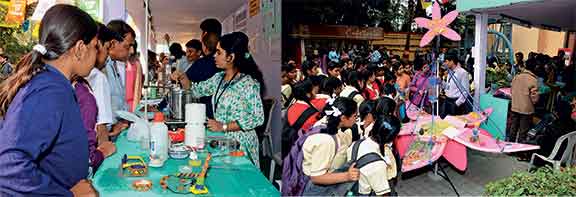Subhashis Das
Science fairs are an annual event in many Indian cities, held under the aegis of the National Council of Science Museums. But it all started in Kolkata at the first science museum of the country – the Birla Industrial and Technological Museum.
At the first science fair held in Kolkata in 1967, 61 students participated with 40 models/exhibits from only 20 schools. This number of students, models/exhibits and schools has now risen to an encouraging figure. In the last five years, on an average, 302 students took part with around 200 models/exhibits from about 200 schools. It also implies that the students understood the importance and significance of the science fair in their curricular science studies as it provides them with opportunities, not only to culture their creativities and activities in science, but to improve the quality of science learning.
Scientific activities of the science fair must have a social end, and there lies the success and fruitfulness of the science fair.
Some of the models exhibited at the Science Fair from 1976 to 1985, such as “Automatic Barrage Protection and Flood Indicator”, “Smoking is Injurious to Health” and “Energy Saving Oven for Village Bakery” show that the students used to devote more time and labour on their projects and that they tried to address some problems and issues in their day-to-day life. The exhibits “Machine for Making Puffed Rice”, “Water Siphon Clock” and “Audio Spirit Level – A Boon for the Blind” also tell us that students made the effort to apply their intellect and creativity comprehensively while preparing the projects. They even associated with the resource persons and appropriate institutions or organizations that could extend the required help and facilities to carry out the works of some investigative and experimental projects for the fair. For instance, the students received collaboration (with the help of BITM) from Geological Survey of India, Regional Institute of Printing Technology, West Bengal Ceramic Development Corpn. Ltd., The Jay Engineering Works Ltd., Zoology Deptt., Calcutta University, Institute of Electronics & Audio-visual Sciences, Meteorological Centre of Kolkata Region, Bio-chemistry Deptt., Calcutta University, Biology Deptt., David Hare Training College, Kolkata and others as per the reports published by BITM on Easter India Science Camp. The result of such collaborative efforts is that the projects are application based, tested, and have scope for future innovation and improvement for use in our society. In this connection, the science teachers, of course, play a vital role in motivating the students and guiding them in the right direction.
The author is a curator, Birla Industrial & Technological Museum, Kolkata. He can be reached at sdas_rscghy@rediffmail.com.


